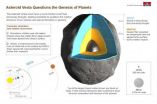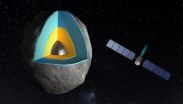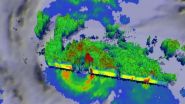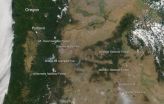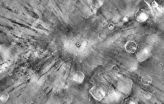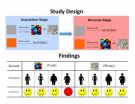(Press-News.org) EPFL researchers have a better understanding of the asteroid Vesta and its internal structure, thanks to numerical simulations and data from the space mission Dawn. Their findings, published today in Nature, question contemporary models of rocky planet formation, including that of Earth.
With its 500 km diameter, the asteroid Vesta is one of the largest known planet embryos. It came into existence at the same time as the Solar System. Spurring scientific interest, NASA sent the Dawn spacecraft into Vesta's orbit for one year between July 2011 and July 2012.
Data gathered by Dawn were analyzed by a team of researchers from EPFL as well as the Universities of Bern, Brittany (France) and Arizona (USA). Conclusion: the asteroid's crust is almost three times thicker than expected. The study does not only have implications for the structure of this celestial object, located between Mars and Jupiter. Their results also challenge a fundamental component in planet formation models, namely the composition of the original cloud of matter that aggregated together, heated, melted and then crystallized to form planets.
At EPFL's Earth and Planetary Science Laboratory (EPSL), led by Philippe Gillet, Harold Clenet had a look at the composition of the rocks scattered across Vesta's ground. "What is striking is the absence of a particular mineral, olivine, on the asteroid's surface," said the researcher.
Olivine is a main component of planetary mantles and should have been found in large quantities on the surface of Vesta, due to a double meteorite impact that, according to computer simulations, "dug" the celestial body's southern pole to a depth of 80 km, catapulting large amounts of materials to the surface.
The two impacts were so powerful that more than 5% of Earth's meteorites come from Vesta. "But these cataclysms were not strong enough to pierce through the crust and reach the asteroid's mantle," Clenet continued.
The meteorites originating from Vesta and found on Earth confirm this since they generally lack Olivine, or contain only minute amounts compared to the amount observed in planetary mantles. Also, the spacecraft Dawn did not find olivine in the vicinity of the two impact craters.
"This means that the crust of the asteroid is not 30 km thick, as suggested by the models, but more than 80 km," said Clenet.
Composition of planets
These discoveries challenge models that describe the formation of Vesta, and consequently the formation of rocky planets in the Solar System, including planet Earth. Cooling theory
and "re-melting" phenomena in the depths of previously solidified elements
would also need to be reviewed.
As the scientist explained, "The
crust might have been thickened by the formation of 'plutons,' that is: igneous rock intrusions, hundreds of meters large, some of which emerged
to the surface."
If Vesta has less of a (olivine-rich) mantle and more of a (pyroxene-rich) crust, then the proportion of materials making up Vesta, and probably the Earth and other telluric planets as well (Mars, Venus, Mercury), is different from what was previously expected.
A more complex model of planet formation therefore has to be considered, one that takes into account
not only the original composition of planets, but also their orbits, sizes and related cooling times. Vesta is the only known asteroid that has an earth-like structure--with a core, mantle and crust--making it an incredible laboratory for testing hypotheses and theories.
INFORMATION:
Video on YouTube, EPFLnews: http://bit.ly/2014VestaYoutube
Nature Online PDF (after Embargo): http://dx.doi.org/10.1038/nature13499
Please contact Nature for a PDF of the scientific publication: press@nature.com
Researcher Contact
Harold Clenet
EPFL Postdoc
Earth and Planetary Science Laboratory http://epsl.epfl.ch/
Languages: French, English
Telephone: +33664757927
Email: harold.clenet@epfl.ch
Media Contact
Hillary Sanctuary
EPFL International Media Relations
Telephone: +41216937022
Email: hillary.sanctuary@epfl.ch
Press Kit (press release, videos, infographic):
http://bit.ly/2014Asteroid
Asteroid Vesta to reshape theories of planet formation
New findings about the asteroid Vesta question contemporary models of rocky planet formation, including that of Earth
2014-07-16
ELSE PRESS RELEASES FROM THIS DATE:
NASA sees Typhoon Rammasun exit the Philippines
2014-07-16
Typhoon Rammasun passed through the central Philippines overnight and NASA satellite imagery showed that the storm's center moved into the South China Sea. NASA's TRMM satellite showed the soaking rains that Rammasun brought to the Philippines as it tracked from east to west.
Before Rammasun made landfall, the Tropical Rainfall Measuring Mission or TRMM satellite passed over the storm and measured cloud heights and rainfall rates. On July 14, 2014 at 18:19 UTC (2:19 p.m. EDT), TRMM spotted powerful, high thunderstorms reaching heights of almost 17km (10.5 miles). Rain ...
Researchers demonstrate health risks posed by 'third hand' tobacco smoke
2014-07-16
Research led by the University of York has highlighted the potential cancer risk in non-smokers – particularly young children – of tobacco smoke gases and particles deposited to surfaces and dust in the home.
Until now, the risks of this exposure known as 'third hand tobacco smoke' have been highly uncertain and not considered in public policy.
However, a new study published in the journal Environment International, has estimated for the first time the potential cancer risk by age group through non-dietary ingestion and dermal exposure to third hand smoke. The results ...
Squid skin protein could improve biomedical technologies, UCI study shows
2014-07-16
Irvine, Calif., July 16, 2014 – The common pencil squid (Loliginidae) may hold the key to a new generation of medical technologies that could communicate more directly with the human body. UC Irvine materials science researchers have discovered that reflectin, a protein in the tentacled creature's skin, can conduct positive electrical charges, or protons, making it a promising material for building biologically inspired devices.
Currently, products such as retinal implants, nerve stimulators and pacemakers rely on electrons – particles with negative charges – to transmit ...
National Psoriasis Foundation awards $1.05 million in research grants
2014-07-16
PORTLAND, Ore. (July 16, 2014)—Thirteen scientists received a total of $1.05 million in funding from the National Psoriasis Foundation for projects that aim to identify new treatments and a cure for psoriasis—an autoimmune disease that appears on the skin, affecting 7.5 million Americans—and psoriatic arthritis—an inflammatory arthritis that affects the joints and tendons, occurring in up to 30 percent of people with psoriasis.
Learn more about the NPF research grant program: http://www.psoriasis.org/research.
This year, three scientists each received a two-year, $200,000 ...
70-foot-long, 52-ton concrete bridge survives series of simulated earthquakes
2014-07-16
VIDEO:
A 70-foot-long, 52-ton concrete bridge survived a series of earthquakes in the first multiple-shake-table experiment in the University of Nevada, Reno's new Earthquake Engineering Lab, the newest addition to the...
Click here for more information.
RENO, Nev. – A 70-foot-long, 52-ton concrete bridge survived a series of earthquakes in the first multiple-shake-table experiment in the University of Nevada, Reno's new Earthquake Engineering Lab, the newest addition to the ...
Dozens of fires plague Oregon
2014-07-16
Fires are a way of life during the hot, dry summer days, but that does not mean they are ever taken for granted. Thousands of lightning strikes Sunday (7/13) and early Monday (7/14) probably started most of the wildfires, which are burning on private, public and reservation land. Dozens of fires are plaguing the forest areas in the state of Oregon. In this image, are shown the Buzzard Fire, the Shaniko Butte fire, the Bridge 99 Complex fire, and the Saddle Draw Fire.
The Buzzard Complex fire began as a lightning strike. Difficult terrain, combined with extremely dry ...
Arizona State University, US Geological Survey project yields sharpest map of Mars surface properties
2014-07-16
Tempe, Ariz. -- A heat-sensing camera designed at Arizona State University has provided data to create the most detailed global map yet made of Martian surface properties.
The map uses data from the Thermal Emission Imaging System (THEMIS), a nine-band visual and infrared camera on NASA's Mars Odyssey orbiter. A version of the map optimized for scientific researchers is available at the U.S. Geological Survey (USGS).
The new Mars map was developed by the Geological Survey's Robin Fergason at the USGS Astrogeology Science Center in Flagstaff, Ariz., in collaboration ...
Organismal biologists needed to interpret new trees of life
2014-07-16
Rapidly accumulating data on the molecular sequences of animal genes are overturning some standard zoological narratives about how major animal groups evolved. The turmoil means that biologists should adopt guidelines to ensure that their evolutionary scenarios remain consistent with new information—which a surprising number of scenarios are not, according to a critical overview article to be published in the August issue of BioScience and now available with Advance Access.
The article, by Ronald A Jenner of the Natural History Museum in London, describes how evolutionary ...
When it comes to food, obese women's learning is impaired
2014-07-16
Obese women were better able to identify cues that predict monetary rewards than those that predict food rewards, according to a study by Yale School of Medicine researchers and their colleagues in the journal Current Biology. The findings could result in specific behavioral interventions to treat obesity.
"Instead of focusing on reactions to the food itself, such interventions could focus on modifying the way in which obese individuals learn about the environment and about cues predicting food rewards," said lead author Ifat Levy, assistant professor of comparative medicine ...
Oregon study details brain pathways linking visual function, running
2014-07-16
EUGENE, Ore. – (July 16, 2014) – A new study by researchers at the University of Oregon published today in the journal Neuron describes a brainstem circuit in mice that may help explain how active movement impacts the way the brain processes sensory information.
"Previous studies have examined changes in the visual cortex of mice during running. What was unknown was how do running and vision get linked together in the first place?" said Cristopher Niell, a biology professor in the Institute of Neuroscience and the senior author on the paper "Identification of a Brainstem ...
LAST 30 PRESS RELEASES:
Automatic label checking: The missing step in making reliable medical AI
Low daily alcohol intake linked to 50% heightened mouth cancer risk in India
American Meteorological Society announces Rick Spinrad as 2026 President-Elect
Biomass-based carbon capture spotlighted in newly released global climate webinar recording
Illuminating invisible nano pollutants: advanced bioimaging tracks the full journey of emerging nanoscale contaminants in living systems
How does age affect recovery from spinal cord injury?
Novel AI tool offers prognosis for patients with head and neck cancer
Fathers’ microplastic exposure tied to their children’s metabolic problems
Research validates laboratory model for studying high-grade serous ovarian cancer
SIR 2026 delivers transformative breakthroughs in minimally invasive medicine to improve patient care
Stem Cell Reports most downloaded papers of 2025 highlight the breadth and impact of stem cell research
Oxford-led study estimates NHS spends around 3% of its primary and secondary care budget on the health impacts of heat and cold in England
A researcher’s long quest leads to a smart composite breakthrough
Urban wild bees act as “microbial sensors” of city health.
New study finds where you live affects recovery after a hip fracture
Forecasting the impact of fully automated vehicle adoption on US road traffic injuries
Alcohol-related hospitalizations from 2016 to 2022
Semaglutide and hospitalizations in patients with obesity and established cardiovascular disease
Researchers ‘listen in’ to embryo-mother interactions during implantation using a culture system replicating the womb lining
How changing your diet could help save the world
How to make AI truly scalable and reliable for real-time traffic assignment?
Beyond fragmented markets: A new framework for efficient and stable ride-pooling
Can shape priors make road perception more reliable for autonomous driving?
AI tracks nearly 100 years of aging research, revealing key trends and gaps
Innovative techniques enable Italy’s first imaging of individual trapped atoms
KIER successfully develops Korea-made “calibration thermoelectric module” for measuring thermoelectric device performance
Diversifying US Midwest farming for stability and resilience
Emphasizing immigrants’ deservingness shifts attitudes
Japanese eels, climate change, and river temperature
Pusan National University researchers discover faster, smarter heat treatment for lightweight magnesium metals
[Press-News.org] Asteroid Vesta to reshape theories of planet formationNew findings about the asteroid Vesta question contemporary models of rocky planet formation, including that of Earth
